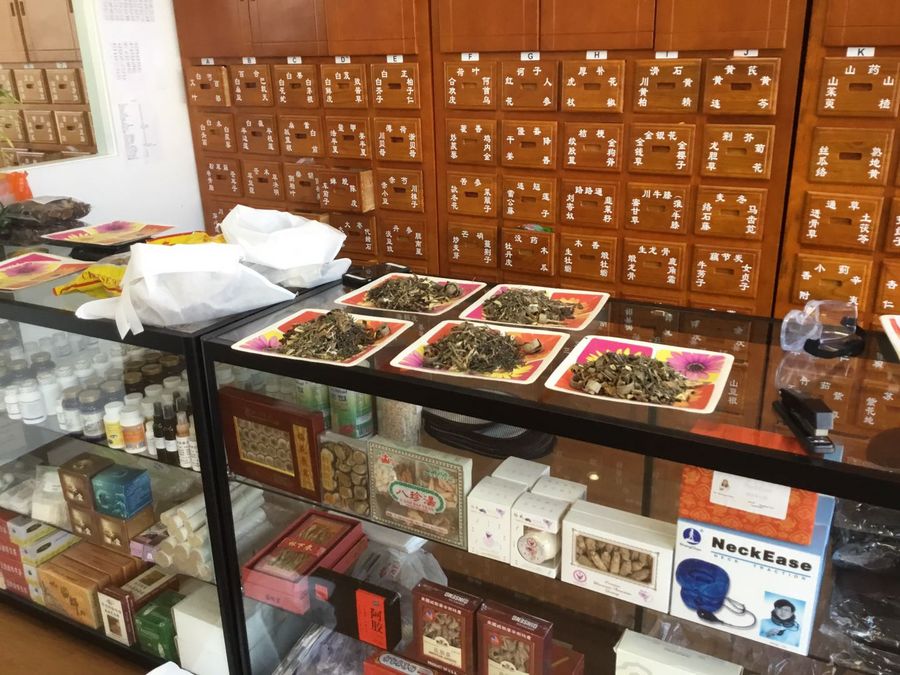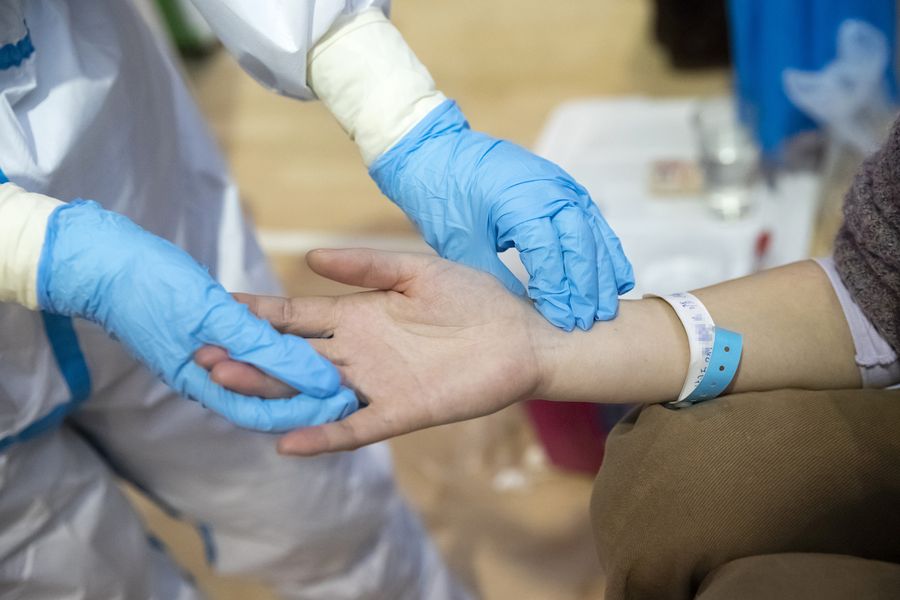- Various studies in China showed that application of TCM alone was sufficient to reduce fevers, symptoms and viral loads for patients at the early stages of infection.
- Local Chinese Americans increasingly turned to TCM for help after the pandemic pushed NYC's public health system to the verge of collapse.
- The TCM approach is "different from but can be highly complementary" with current molecular medicines evolved from Western medicine, which focus more on the microscopic level and single targets to treat diseases.
by Xinhua writers Yang Shilong, Hu Yousong, Liu Jie
WASHINGTON, April 22 (Xinhua) -- "I am writing to tell you that we three senior ladies have fully recovered. We're so grateful for your help at this difficult time," a WeChat message sent to a practitioner of traditional Chinese medicine (TCM) read.
When the message popped up on Monday afternoon, Chen Decheng was so happy that he felt that all the fatigue resulting from his month-long hard work had miraculously disappeared.

A medical worker gives acupuncture treatment to a cured COVID-19 patient at the Hubei Provincial Hospital of Traditional Chinese Medicine in Wuhan, central China's Hubei Province, April 21, 2020. (Xinhua/Wang Yuguo)
The TCM practioner in New York City, the epicenter of the U.S. COVID-19 outbreak, clearly remembered how desperate the sender, 71-year-old Xu Lei, had sounded when she told him over the phone that she had a persistent fever, dry cough and other obvious symptoms of COVID-19.
And so were Xu's 73-year-old sister and 68-year-old friend who live together with her in NYC's borough of Manhattan.
Chen, who has over 20 years of experience in traditional Chinese medicine, immediately made diagnoses for the three seniors via video WeChat and prescribed a tailored TCM remedy for each of them.

Photo taken on April 14, 2020 shows herbs at Chen Decheng's De Yi Tang acupuncture clinic in Great Neck, New York, the United States. (De Yi Tang/Handout via Xinhua)
"CHINESE EXPERIENCE SO HELPFUL"
"The prescriptions aim to help improve their lung function, lower their body temperature and boost their immune system," said Chen, who got his Ph.D. from Nanjing University of Chinese Medicine in China's Jiangsu Province in the early 1990s, in a recent interview with Xinhua.
Chen, who runs two TCM and acupuncture clinics in NYC and neighboring Long Island, said his approach was in line with recommendations shared by his Chinese counterparts for treating COVID-19 symptoms. "China's experiences in the area are so helpful to people like me in the West," Chen said.
China's National Health Commission prescribed the use of TCM alongside Western drugs in its guidelines for the treatment of people infected with the virus as early as late January.
Various studies in China showed that application of TCM alone was sufficient to reduce fevers, symptoms and viral loads for patients at the early stages of infection. For those in severe condition, the use of TCM, in conjunction with various antiviral protocols, could help patients recover.
Jin Ming, founder and medical director of Ming Qi Natural Healthcare Center in Manhattan, had brought back a batch of Chinese herbs used for the prevention and treatment of COVID-19 symptoms when she returned after spending Spring Festival in China.
"China was working hard fighting COVID-19. No one at that time would imagine that the pandemic would worsen to such an extent in the U.S.," Jin told Xinhua via WeChat.
The virus has infected over 800,000 people, with deaths surpassing 43,000 in the United States alone as of Tuesday. New York state remains the hardest-hit state with over 250,000 cases and 18,821 deaths.

Photo taken on April 14, 2020 shows packs of traditional Chinese medicine for take-away outside Chen Decheng's De Yi Tang acupuncture clinic in Great Neck, New York, the United States. (De Yi Tang/Handout via Xinhua)
OVERWHELMED BY PATIENTS' CALLS
Both Chen and Jin closed down their clinics and moved their diagnosis and prescription services online days before the New York state governor issued a stay-at-home order intended to curb the spread of COVID-19 in late March.
The two TCM doctors have since been bombarded daily by phone calls from potential patients as local Chinese Americans increasingly turned to TCM for help after the pandemic pushed NYC's public health system to the verge of collapse.
"I am kind of scared myself initially. It's often the case that a person made an appointment with me, and it always turned out to be for the whole family," said Chen.
Thanks to social networking apps like WeChat and Facetime, TCM doctors can have a "relatively comprehensive view" of a patient by conducting three of four TCM ways of diagnosis -- looking, listening, and questioning, he said.
COVID-19, as agreed by Chinese TCM experts, is a cold and dampness-related illness, said Chen.
The deadly disease could be caused by the imbalance of Yin and Yang -- two opposite yet complementary energies -- in one's body, as a result of living in a humid and wet area.
Noting a patient's tongue is an "important diagnostic tool," Chen said that "a pale and moist tongue with a thick white coating is an indication of excessive dampness."
As the disease develops, the color of the tongue coating darkens to yellow and the tongue's color also darkens to red or purple. The patient could get worse when his or her tongue coating gets thick, dry and cracked, even without an obvious cough and shortness of breath.
To help reduce his workload, Chen's patients learned to take selfies of their tongue coatings daily with a clear indication of date and time.
The doctor then could easily tell if a COVID-19 patient was getting better or worse by simply comparing his or her tongue coating records.

Medical staff work at a traditional Chinese medicine pharmacy in Weinan City, northwest China's Shaanxi Province, Feb. 20, 2020. (Xinhua/Tao Ming)
EXPLORING WEST-EAST ("WE") MEDICINE
As no cure has yet been found for COVID-19, TCM can help in relieving the associated symptoms, Chen and Jin said.
"Taking a holistic measure in treatment, TCM actually does not care (i.e. differentiate whether) a person has tested positive or negative for the virus," and what TCM practitioners do is try to adjust the whole body's health and improve a patient's immunity so that he or she can better fight the virus, Chen said.
TCM, though not officially recognized in the United States and the West, has been around for more than 3,000 years, Jin said, and it has helped fight pandemics in the past, including SARS.
Addressing doubts surrounding the TCM approach in the West and China, the doctors said "for many in the pandemic, the foremost thing is to save lives, it's good if the method reduces the symptoms a little bit, and the more the better."
As TCM practitioners usually do, Jin, Chen and their colleagues help cook, pack prescribed herbs, and have them delivered to the doorsteps of patients if needed.
Most of his patients showed signs of recovery after having one decoction of herbal medicine twice a day for five or 10 consecutive days, Chen said.
For the Chinese community in New York, TCM, in addition to alleviating the pains associated with an illness, also serves as a valuable platform for psychological support, Jin said.

A medical worker examines a patient with traditional Chinese medicine (TCM) therapies in Wuhan, central China's Hubei Province, Feb. 25, 2020. (Xinhua/Shen Bohan)
"At least you can get hold of a professional speaking your own language to alleviate the fear, confusion and helplessness brought about by the virus," she said.
The TCM approach is "different from but can be highly complementary" with current molecular medicines evolved from Western medicine, which focus more on the microscopic level and single targets to treat diseases, Yung-Chi Cheng, Henry Bronson Professor of Pharmacology at Yale University, told Xinhua over the phone recently.
"In order to meet unmet future health needs, neither Eastern (E) medicines, exemplified by TCM, nor Western (W) medicines, exemplified by current conventional medicine, is sufficient," Cheng said.
"The most effective approach for developing future medicine to meet unmet clinic needs should be the melting of 'W' and 'E' into 'WE' Medicine," he said.
(Video reporters: Yang Shilong, Hu Yousong; Video editor: Wei Yin)■



